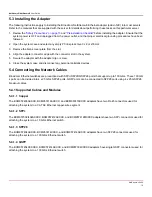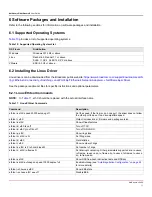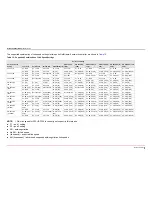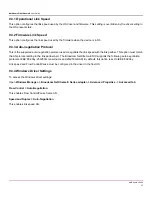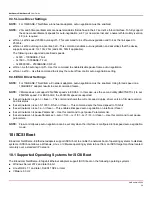
NetXtreme-UG100
29
NetXtreme-C/NetXtreme-E
User Guide
10.2 Setting up iSCSI Boot
Refer to the following sections for information on setting up iSCSI boot.
10.2.1 Configuring the iSCSI Target
Configuring the iSCSI target varies per the target vendor. For information on configuring the iSCSI target, refer to the
documentation provided by the vendor. The general steps include:
1. Create an iSCSI target.
2. Create a virtual disk.
3. Map the virtual disk to the iSCSI target created in
Step 1 on page 29
.
4. Associate an iSCSI initiator with the iSCSI target.
5. Record the iSCSI target name, TCP port number, iSCSI Logical Unit Number (LUN), initiator Internet Qualified Name
(IQN), and CHAP authentication details.
6. After configuring the iSCSI target, obtain the following:
– Target IQN
– Target IP address
– Target TCP port number
– Target LUN
– Initiator IQN
– CHAP ID and secret
10.2.2 Configuring iSCSI Boot Parameters
Configure the Broadcom iSCSI boot software for either static or dynamic configuration. Refer to
Table 18
for configuration
options available from the General Parameters menu.
Table 18
lists parameters for both IPv4 and IPv6. Parameters specific
to either IPv4 or IPv6 are noted.
Table 18: Configuration Options
Option
Description
TCP/IP parameters via DHCP
This option is specific to IPv4. Controls whether the iSCSI boot host software acquires
the IP address information using DHCP (Enabled) or use a static IP configuration
(Disabled).
IP Autoconfiguration
This option is specific to IPv6. Controls whether the iSCSI boot host software configures
a stateless link-local address and/or stateful address if DHCPv6 is present and used
(Enabled). Router Solicit packets are sent out up to three times with 4-second intervals
in between each retry. Or use a static IP configuration (Disabled).
iSCSI parameters via DHCP
Controls whether the iSCSI boot host software acquires its iSCSI target parameters
using DHCP (Enabled) or through a static configuration (Disabled). The static
information is entered through the iSCSI Initiator Parameters Configuration screen.
CHAP Authentication
Controls whether the iSCSI boot host software uses CHAP authentication when
connecting to the iSCSI target. If CHAP Authentication is enabled, the CHAP ID and
CHAP Secret are entered through the iSCSI Initiator Parameters Configuration screen.
DHCP Vendor ID
Controls how the iSCSI boot host software interprets the Vendor Class ID field used
during DHCP. If the Vendor Class ID field in the DHCP Offer packet matches the value
in the field, the iSCSI boot host software looks into the DHCP Option 43 fields for the
required iSCSI boot extensions. If DHCP is disabled, this value does not need to be set.


